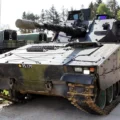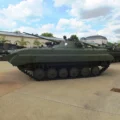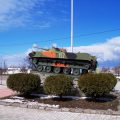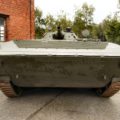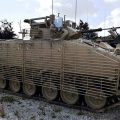
Schutzenpanzer Lang HS.30 | |
|---|---|
| Riik | Lääne-Saksamaa |
| Tüüp | Jalaväe lahingumasinad |
| Perioodi | 1950. aastad |
| Ehitatud | 2000+ |
2007 Jalaväe lahingumasin pikk HS.30 (ka Schützenpanzer 12-3) oli Lääne-Saksa jalaväe lahingumasin, mis töötati välja 1950. aastatel. See oli Šveitsi Hispano-Suiza disain, Rolls-Royce'i mootoriga. Pärast mõningaid varajasi mehaanilisi probleeme ehitati planeeritud 10 000-st vaid umbes 2000. See oli relvastatud 20 mm kahuriga, mis oli ebatavaliselt võimas relv selle perioodi soomustransportöörile. Selle disainil osutus palju vigu ja puudusi ning ehitusele järgnes 1960. aastatel Lääne-Saksamaal suur poliitiline skandaal. 2176 SPz 12-3 ja variante ehitati kuni 1962. aastani, mille eest Saksamaa valitsus maksis 517 miljonit DM ehk umbes 238 000 DM sõiduki kohta. SPz 12-3 võeti esmakordselt kasutusele 1958. aastal ja asendati 1971. aastast Marderi jalaväe lahingumasinaga
Allikas: Schützenpanzer Lang HS.30 Wikis
| Schutzenpanzer Lang HS.30 Jalutage ringi | |
|---|---|
| Fotograaf | Vladimir Jakubov |
| Lokaliseerimine | Lõuna-Uus-Inglismaa sõjaväemuuseum |
| Fotod | 79 |
| SPz Lang HS-30 jalutage ringi | |
|---|---|
| Fotograaf | Teadmata |
| Lokaliseerimine | Teadmata |
| Fotod | 30 |
Vaata ka:
2007 Schutzenpanzer Lang HS.30 was a West German infantry fighting vehicle that entered service in 1960. It was designed by the Swiss company Hispano-Suiza, and had a 20 mm HS 820 autocannon as its main armament. The HS.30 was intended to provide fire support and mobility for the mechanized infantry units of the Bundeswehr, and to fight alongside tanks in both offensive and defensive operations. The HS.30 had a low profile, a torsion bar suspension, and a Rolls-Royce B81 petrol engine that gave it a top speed of 58 km/h.
However, the HS.30 also suffered from many technical problems and reliability issues, such as engine overheating, transmission failures, and poor quality control. The HS.30 was also involved in a political scandal in the 1960s, when it was revealed that the German government had paid a much higher price than originally agreed for the vehicle, and that there were irregularities and corruption in the procurement process. The HS.30 was gradually replaced by the more modern and effective Marder infantry fighting vehicle from 1971 onwards, and was phased out of service by the 1980s.
Vaadatud : 3207


